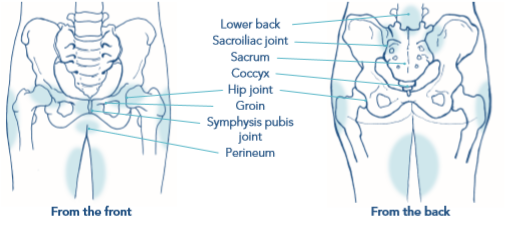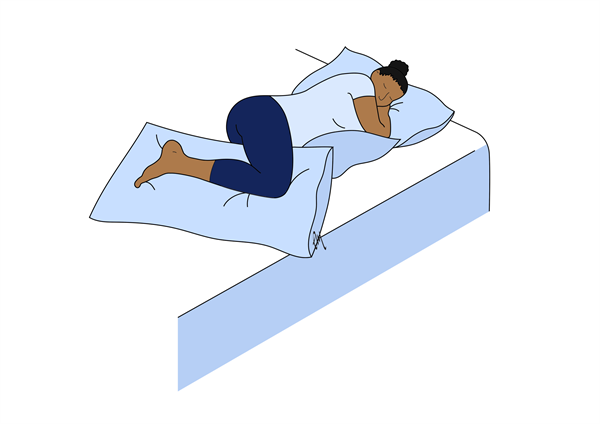Pregnancy related Pelvic girdle pain and low back pain during pregnancy and after having a baby
Explanation of common symptoms/ problems
If you are feeling pain in your pubic bone, groin, hips, buttocks and/ or tail bone it may be that this is due to pregnancy related pelvic girdle pain/ pelvic girdle pain (PRGP/PGP). PRGP also used to be called symphysis pubis dysfunction or SPD.

Sites where you may experience pain
This pain happens for approximately 20% of pregnant women and can happen at any stage of pregnancy. It can also continue or develop for a small number of women after having a baby.
More common in pregnancy is lumbopelvic pain (pain in the lower back and/or back of the pelvis). This happens for 50% of pregnant women.
These conditions often happen due to problems with how the muscles and joints of the back and the pelvis are working. There may be:
- Uneven movement of the joints of the lower back or pelvis
- Weakening of the tummy, buttocks, inner thigh and pelvic floor muscles. This puts more stress and strain on the joints of the lower back and pelvis.
- A previous injury of the lower back or pelvis
- Occasionally pain can be due to the position of your baby
- For a small number of women, pain is due to the hormonal changes of pregnancy.
If you have a physical job, gained a large amount of weight during your pregnancy or had PGP or low back pain in a previous pregnancy you are more likely to have pain this pregnancy.
For women who have just had a baby, sitting in one position for a long-time feeding, lifting and carrying your baby and baby equipment can put a large amount of strain on your back and pelvis and cause pain.
Other activities that are often painful are:
- Standing on one leg (i.e. getting dressed, using the stairs)
- Moving legs apart (i.e. getting in/ out of bed or the car)
- Lying in some positions
- Sexual intercourse
Self help / Advice
There are lots of things that you can do which can help your pain such as:
- Pacing yourself. Try not to get all of your daily jobs done in one go. Break up the activities and have a rest in between. Similarly try to take regular breaks at work and change the position that you are in.
- If you are struggling with walking make sure that you are wearing supportive footwear. Try to slow down your walking speed and don’t walk so far.
- Try not to push through activities that make your pain worse.
- It is good to stay active but you may just need to find the right exercise/ activity to help. (Take a look at our leaflets, Fit for pregnancy and Exercise and advice after pregnancy, for exercise ideas.)

- Place a pillow between your knees for sleeping
- Try to keep your knees together and turn slowly in bed. Do the same when getting in and out of the car.
- Think about how you are sitting. Try not to sit with your legs crossed or underneath you. Placing a cushion behind your back may help. And if you are breastfeeding using a feeding pillow can be more comfortable.
Where to go to next
It is important to ask for help with your pain if it does not improve with the advice given here or if you are struggling with sleep and daily activities. Speak with your midwife/ GP in the first instance. They should advise you to see a specialist pelvic health physiotherapist who is trained to treat PGP and lower back pain in pregnancy. You can also contact the POGP who may be able to help find a specialist physiotherapist where you live.
Find a Physiotherapist
POGP booklets:
Other good sources of information are:
For a small number of women there will be a different cause for their pain which needs urgent medical attention. If you experience any of the following:
- Pain going down both legs at the same time,
- Numbness in both legs at the same time,
- Difficulty passing urine,
- Leakage of stool from the bowel that you couldn’t control
- Numbness around the vaginal or back passage
Call your GP straight away or go to your nearest A&E department.
What to expect from physiotherapy
Physiotherapists who treat pregnant women have specialist training and they are used to treating people who have these problems. They will carry out a thorough assessment to find out why you are getting these symptoms and explain what can be done to help improve them. They will make sure that the treatment is very specific to your symptoms. If the physiotherapist thinks that your problem is not PGP/ LBP but some other cause they may suggest that you see another health care professional, such as your GP, to look into your problem further.